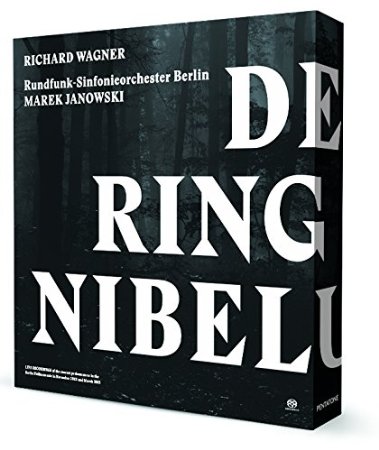WAGNER Der Ring des Nibelungen
View record and artist detailsRecord and Artist Details
Composer or Director: Richard Wagner
Genre:
Opera
Label: Pentatone
Magazine Review Date: 08/2016
Media Format: Super Audio CD
Media Runtime: 829
Mastering:
DDD
Catalogue Number: PTC5186 581

Tracks:
| Composition | Artist Credit |
|---|---|
| (Der) Ring des Nibelungen: Complete |
Richard Wagner, Composer
Andreas Conrad, Mime, Tenor Anja Fidelia Ulrich, Gerhild, Soprano Anna Larsson, Erda, Contralto Berlin Radio Symphony Orchestra Christa Mayer, Second Norn, Mezzo soprano Christian Elsner, Loge; Mime, Tenor Edith Haller, Gutrune, undefined Günther Groissböck, Fasolt, Bass Iris Vermillion, Fricka, Mezzo soprano Jacquelyn Wagner, Third Norn, Soprano Jochen Schmeckenbecher, Alberich, Baritone Lance Ryan, Siegfried, Tenor Marek Janowski, Conductor Maria Radner, Erda, Contralto Marina Prudenskaja, Waltraute, Soprano Markus Bruck, Gunther, Baritone Matti Salminen, Fafner; Hagen, Bass Melanie Diener, Sieglinde, Soprano Petra Lang, Brünnhilde, Mezzo soprano Ricarda Merbeth, Freia, Soprano Richard Wagner, Composer Robert Dean Smith, Siegmund, Tenor Sophie Klussmann, Woodbird, Soprano Stephen Gould, Siegfried, Tenor Susanne Resmark, First Norn, Mezzo soprano Timo Riihonen, Fafner; Hunding, Bass Tomasz Konieczny, Wotan; Wanderer, Bass-baritone Violeta Urmana, Brünnhilde, Soprano |
Author: Mike Ashman
Heard purely in stereo, the sound and balance on these discs are transparently clear in their evenness. The engineering and Janowski always make sure that we hear the voices (naturally, not exaggeratedly over-forward) with plenty of room around them, while the instruments still speak clearly. Try the ‘French’ wind and string filigrees around the swimming Rhinedaughters or – in a more heavily scored sequence – the Wanderer/Erda duet from Siegfried.
Despite a gap between recorded performances of no less than 30 years, the two Janowski Rings have much in common from the conductor’s point of view. He continues to present a swift traversal of each opera, relatively free of handed-down Germanic performing traditions yet sharing something with the lighter-textured readings, also live, of Clemens Krauss (Pristine, Bayreuth 1953) and Wolfgang Sawallisch (EMI – nla, Munich 1989) – the lyrical, unweighty ‘Italian’ approach so loved by Wieland Wagner. Janowski’s first Ring looked backwards musically to the early German Romantics (Weber, Mendelssohn etc) rather than forwards. That is still true – try the first Gibich scene, not at all the heavy, gloomy experience traditionally made of it, where Matti Salminen’s seemingly ageless Hagen even takes on some aspects of a comic bass role in his ensnaring of Gunther and Gutrune. However, light and swift he may be, but Janowski still creates a modern-instrument romantic sound picture; he never leans towards the period-conscious approach adapted by Simon Rattle in Das Rheingold (BR-Klassik, 10/15) or Hartmut Haenchen in his filmed Amsterdam Ring (Opus Arte, 7/06, 10/06).
Whatever his views on modern stage production, Janowski has not left his dramatic brains behind. He deserves credit for casting for vocal colour, individuality and rightness rather than playing safe – as rather a lot of record company-led Wagner does – through sheer weight of tone or security in tessitura. In the Dresden cycle his distinguishing choices included a serious Loge and Mime, a clearly acted-out and interpreted Siegfried and a youthful Brünnhilde. He opted for a ‘classical’ Lieder singer (Peter Schreier) as Loge and Mime, an artist with a background in operetta rather than music drama (René Kollo) as Siegfried and a Brünnhilde new to the role (Jeannine Altmeyer). These ideas were continued in 2012/13 with a prominent concert singer, Christian Elsner, as Loge and Mime, and a sharing of the Siegfrieds and Brünnhildes, the better to reflect character. For young Siegfried Stephen Gould, after two recordings with Christian Thielemann, was encouraged to rethink his texts for colour and even fun. The Brünnhildes are imaginatively divided between the torn, more human psychological character in Walküre and Götterdämmerung (Petra Lang) and Siegfried’s more remote goddess (Violeta Urmana).
Janowski’s second Ring boasts the clear thinking in vocal matters, organised discipline and rehearsed detail from before, now captured in actual performance. This gets some of the best of both worlds – potential concert accuracy and good contact plus the adrenalin of a live occasion. It’s only if you compare recent work heard in the theatre under Christian Thielemann (DG, Vienna State Opera) or Daniel Barenboim (ArtHaus Musik, La Scala) that, whatever the relative merits of the casts, there seems to be a greater, more natural musical involvement where actual stage work as part of the rehearsal process has informed the performers’ choices.
In terms of atmosphere, Janowski’s reading still lacks the dark heroics of evil grandeur that blaze through these scores whenever the ‘baddies’ Hagen or Alberich think they’re winning – or even (earlier in the cycle) when Wotan thinks his plan of getting back the ring via his children is working. This is not a colour in Janowski’s palette, although it is in other lyric interpreters’ such as Clemens Krauss (Pristine, Bayreuth 1953) or Kempe (try his final Ring, Opera Depot, Stockholm 1975), Barenboim (Warner, Bayreuth 1991/92 or 2013’s special Proms broadcasts) and Goodall (Chandos, English National Opera 1974/78). These less good-sounding rival Rings from the opera house constitute a more rounded listening experience, for all Janowski’s undoubted success in casting and performing the Ring a second time.
Discover the world's largest classical music catalogue with Presto Music.

Gramophone Digital Club
- Digital Edition
- Digital Archive
- Reviews Database
- Full website access
From £8.75 / month
Subscribe
Gramophone Full Club
- Print Edition
- Digital Edition
- Digital Archive
- Reviews Database
- Full website access
From £11.00 / month
Subscribe
If you are a library, university or other organisation that would be interested in an institutional subscription to Gramophone please click here for further information.




